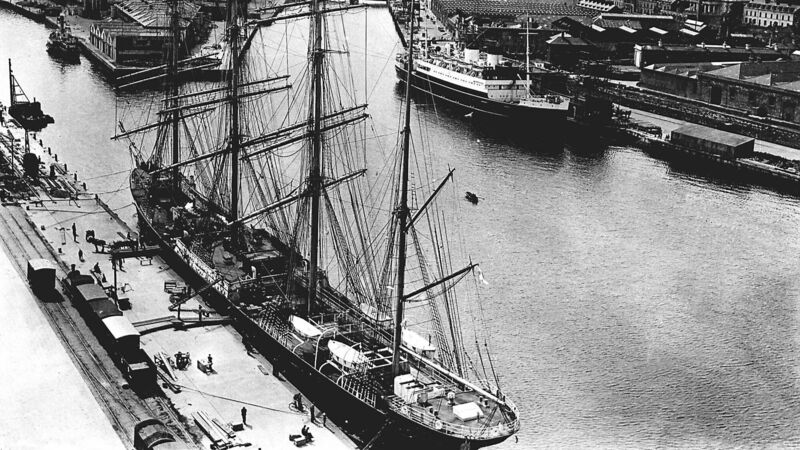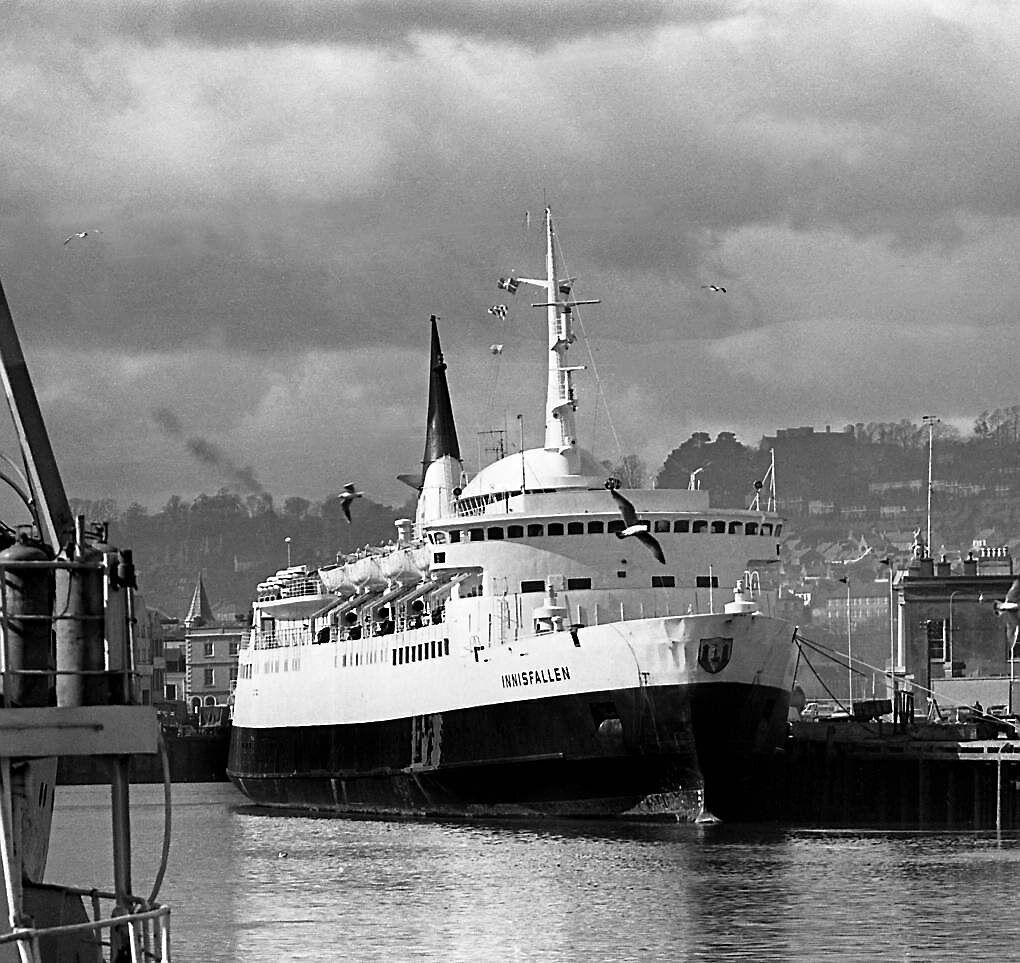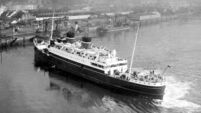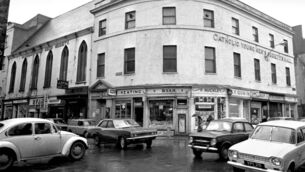Throwback Thursday: The day my family left Cork on the Innisfallen

The ‘Innisfallen’, in the background right, berthed in Cork Port in June, 1936. Reader Teresa Ryan’s family left Cork on it four months later. The four-masted ‘Moshulu’ is the vessel in the foreground
YESTERDAY, in a strange juxtaposition, we were faced with Valentine’s Day and Ash Wednesday on the same date.
This must, presumably, have happened before (like all those Friday the 13ths) but one suspects this is a little unusual, if not quixotic.
On one hand, you have the celebration of love and affection, loyalty and deep commitment; on the other, the beginning of a purgatorial season of 40 days fasting and penitential practices.
One cannot help wondering what the erstwhile Bishop of Cork, the legendary Connie Lucey, would have done with that clash of dates. He certainly wouldn’t have cancelled Ash Wednesday and Lent, that’s for sure.
No, St Valentine and the whole red heart of love would almost certainly have been ‘spoken out’ from the altar and banned.

Here is an interesting fact. The ashes placed on foreheads yesterday go back a lot further than the arrival of Christianity on this island. It was part of the yearly ritual in the far older pagan Ireland to light sacred fires at certain times of the year, among them Imbolc, at the beginning of February.
All household fires were rekindled from this ritual one (which required the use of nine special separate types of wood), and then the ashes were spread on fields to ensure fertility on the year ahead. They were also marked on children’s clothing with a stick in an ‘x’ shape, to protect them from evil spirits.
Christianity simply adapted the traditional practice for its own purposes, as it did with so many of our ancient customs.
And then there are the fasting days, which until recently were observed here, not only on an increased basis in Lent, but throughout the year on Fridays, when fish only could be eaten, not meat.
Did you know that in Elizabethan England, with the danger of a Spanish invasion looming ever closer, Elizabeth I decreed that there should be three fast days in the week instead of just one? This resulted, naturally, in an increased demand for fish, and thus for fishing and fishermen. In this way, Good Queen Bess was able to get far more men trained in the ways of ships and the sea, so that she would have a better navy with which to meet the threatening Armada.
Good thinking, you have to admit.
Reader Tim Cagney has been thinking about the beginning of Lent.
“Ash Wednesday is immediately preceded by Shrove Tuesday. This derives from the word ‘shrive, or ‘absolve,’ and was supposed to remind us to repent and mend our ways,” he writes.
“But of course, it is also famous for its association with pancakes. This, I understand, originates from a time when, prior to Lent, devout people would try to use up all those things forbidden in the days ahead, particularly eggs, butter, and milk, which made pancakes.
“I realise that in America, and even the UK, these are served with anything from ice cream to maple syrup, but there was nothing like that for us up on Gardiner’s Hill. A sprinkle of sugar - and, perhaps, a dash of lemon-juice - were quite good enough!”
Yes, we all have memories of those wonderful Shrove Tuesday pancakes, Tim, and never spared a thought for the hard-working mother standing over the stove, turning out one after another while we clamoured for more and yet more.
Tim has an entertaining childhood memory of Lent to share.
“On the morning of Ash Wednesday, 1960, on my return from Mass, I felt quite ill. I attributed this - mistakenly - to the lemon-juice I had ingested the previous evening.
“It actually turned out to be something more serous - hepatitis.
“Confined to bed for the next six weeks. I wasn’t allowed meat, eggs, butter or many other things I loved.
“The doctor prescribed a concoction with a raspberry flavour, which was actually vile. In addition, I had to eat egg-white (no yolk) and lots of glucose. This, when mixed with water, was vomit-inducing.
“My ever-resourceful mother discovered a thing called ‘Pak-Orange’, a concentrate you diluted with water. This enabled me to ingest 5lbs of glucose, in all.
“Why do I remember the year as being 1960? It was the year I sat my Primary Certificate, which I passed, despite a six-week absence from school.
“The essence of all this, of course, is that I achieved every schoolboy’s dream - I actually ‘gave up school’ for Lent!”
And there aren’t many of us who can proudly claim that, Tim! Well done.

Pat Kelly has written from Blackrock about those famous Thompson’s cakes which surface on these pages from time to time.
“Hi, Jo. On Throwback Thursday of February 1, those references to chocolate slices and Old Mill Confectionery brought a tsunami of memories.
“I remember some time ago my best buddy, Liam, knowing that I had worked in Thompsons, sent me a picture of a baker tending ovens there. I didn’t delay, I drove right over to Brackens Bakery in Blackpool with a laminated copy of that same picture, and handed it to Declan Bracken. He was delighted with it, and even more so when he found that I had known his grandfather back when I was working at that huge place in McCurtain Street.
“Paddy Bracken in fact had three sons who were confectioners in Thompsons: Dennis, Pat Jr, and Thomas. Pat was Declan’s father, and Dennis Bracken was the one who made the chocolate slices.
“I worked there for 11 years, while much later I also worked in Fitzgerald’s bakery for another 11 years.
“Thanks to Throwback Thursday, I keep on rediscovering lost memories of times long gone but never forgotten!”
Pat claims that the Best Brack, the Celebrated Brack, the Brooklyn, and jam tarts WERE Thompsons. To that this author would add the much-loved and lamented ‘sneckin’, or iced currant bun, sometimes bought as a treat from one of that establishment’s outlets on a shopping trip into town.
“Also,” continues Pat Kelly, “you mentioned the shop at the corner of College Road and HighfieId Avenue. This was on my daily walk into Cork.
One day, I spotted chocolate slices in the Market, so I bought four, looking forward to a cupan tae and a treat. Sadly, the slices may have looked like Thompson’s originals, but they emphatically were not.
“On that same topic of cakes, I remember at one time buying jam tarts from a local shop, only to discover that the middle tart had had a big bite taken out of it, before being carefully replaced in the pack!”
That must have been pretty off-putting, Pat. Can’t imagine it happening in the great old days of Thompson’s, when the Clydesdale-drawn drays rolled out in their dozens from the huge bakery into McCurtain Street and all around the city.
The late, great Billa Connell used to drive vans for Thompson’s too, and would take his vehicle down to the Coal Quay where the shawled ladies would choose their own confection from the back doors and pay him promptly. It was a sad loss, Thompson’s.
Another sad loss, one we Corkonians never cease to grieve for, was the great old Innisfallen, the boat (in its several manifestations over the century) that took so many over to Fishguard en route to London and possible employment at Dagenham.
Not just emigrants used the Innisfallen - back then, before flying became the norm, anyone travelling to the UK or beyond would start their journey down on Horgan’s Quay where, before drive-on ferries appeared, any cars making the journey would be slung on board by the use of nets and cranes.
Cattle, too, were driven across from the sheds where they had been herded beforehand, to stand stoically in their pens on board as the sturdy pride of Cork ploughed across the sea to Wales.

We have heard from Teresa Ryan in England on that very topic of the Innisfallen, and she raises a query that should interest readers:
“Dear Jo. I found your email address in The Echo Daily Ezine. My parents moved to England in October, 1936, six years before I was born. What I really would like to know is: what was the price of tickets on the Innisfallen from Cork to Fishguard in 1936?
“My family at the time consisted of two adults, a three-month-old baby, and four older children, aged 2, 4, 6, and 8.”
Naturally enough, we were fascinated by this snippet of personal history and asked for more detail on her family background here, as it would help to place them in Cork before that move to the UK. Teresa obliged.
“My father was John Ross from a townland called Kilnahera, three miles to the east of Drimoleague, Co. Cork. When he made the decision to go over to England, the first farm he worked on was at Piddington, in Oxfordshire. Before he moved to England he was a caretaker at Skibbereen Hospital, at which time he lived on a townland called Shandrum near Drinagh.”
Would anyone reading Throwback Thursday, she asks hopefully, know if English farmers advertised for farm labourers in the Irish newspapers at that time?
“I suspect this is how my father found a job on an English farm,” adds Teresa. “A house went with the job.”
Well, that would certainly have tempted any young married man with a growing family in the harsh conditions that were a fact of rural Ireland in the 1930s.
Such information can usually be tracked down in the archives of national and local newspapers. Certainly, in the 19th century there were plenty of advertisements from boat services offering to take labourers to the potato-picking in both Scotland and England, and presumably this practice would have continued into the 20th century.
Often these jobs were seasonal only, and young men would head out at the start of the picking season, leaving their families at home to care for the land, while they moved from one area to another across Scotland and England, saving their hard-earned wages to bring home at the end of the season and see their wives and children through another winter.
As for how much it cost to bring your entire family over on the Innisfallen in 1936, Teresa, that’s a question requiring a bit of online research, I would think, I know my own parents went on honeymoon two years later, in Dec 1938, and used the Innisfallen en route to Switzerland, but although I know the cost of the Swiss trip to and from London was a staggering £27 (Victoria-Dover-Calais-Basle-Adelboden), the fare on the Cork boat is not recorded. Most probably, a generous parent subbed that part of the trip as a wedding gift.
We do know that in 1936 your family would have travelled on the new boat, launched in 1930. With diesel engines and a tonnage of 3,019, she was the only passenger boat on the South Wales run. As it happened, she was the ship that took the last British soldiers based at Spike Island home in 1938 - a few months before my newly-wed parents took the same route, but on a happier occasion.
Now come on, you indefatigable researchers out there. Any idea of the price of a one-way family ticket back then? Let’s hear your findings! And any other memories these pages have awoken. Email jokerrigan1@gmail.com. Or leave a comment on our Facebook page: https://www.facebook.com/echolivecork.







